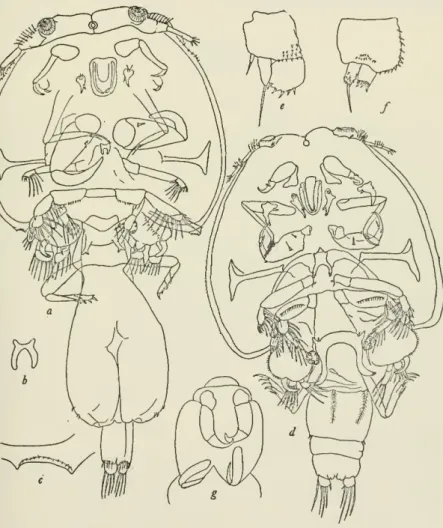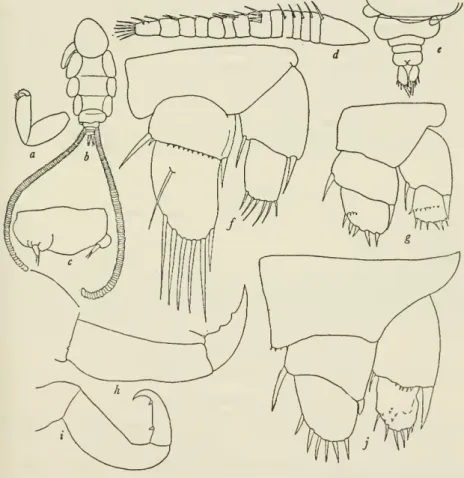Zaus goodsiri Brady, A monograph of the free and semi-parasitic Copepoda of the British Isles, vol Genital segment slightly more than half as long as wide, with bilateral elliptical areas; each bearing on the posterior medial margin a narrow lamina armed with four setae. First antennae 2-segmented; first segment almost as long as the second, armed with 19 setae on the anterior and 3 on the lateral.
34;rough hand") refers to it; the terminal hook is armed midway with a strong sharp spine, which rests against a node on the preceding segment, which is also armed with two short sharp spines near the tip of the hook. Second leg biramous , basal segment twice as long as wide, exopod 3-segmented, proximal segment with two spines The fifth leg is represented by three spines at the posterior-lateral margin of the genital segment.
On the basal segment of the first antenna there are several small setae lateral to the lunule; second segment longer than. Maxilliped with two setae near base of second segment; terminal claw curved, with two strong appendages. Furcula with a base about as long as the diverging branches, with a small spine at each of the anterior angles and a strong median anterior spine.
The fifth leg is represented by two short spines at the posterior end of the genital segment.

PARASITIC CRUSTACEA FROM BIMINI — PEARSE 351 Anisotremus virginicus (Linnaeus), eight from the gills of mar-
352 PROCEEDINGS OF THE NATIONAL MUSEUM VOL. 101
PARASITIC CRUSTACEA FROM BIMINI — PEARSE 353 margins ; exopcd with four strong terminal spines and others on
PARASITIC SCALDATION OF BIMINI— PEARSE 353margins; exopcd with four strong terminal spines and others on. Second antenna stout, the terminal hook bearing two small spines and the preceding segment with one short spine. First maxilla with two stout terminal setae, one of which is three times the length of the other; wide space (0.25 mm.) between the antennae and the first maxillae.
Second leg with exopod ending in a piston armed with large and small spines; endopod with one terminal seta. The third legs have an endopod less than a fourth as long as the exopod; that of the fourth leg is less. Host.— A single male taken from the gills of the longfin albacore, Germo alalunga (Gmelin).
PARASITIC CRUSTACEA FROM BIMINI — PEARSE 355
Caudal rami slender, tapering, twice as long as genitalia; opposite with three short setae. Second to fourth thoracic segments wider than genital segment, which is about as long as the rest of the thorax. First legs spinulose on basipod; exopod with five terminal spines; endopod setose on median border, with one terminal spine.
Second legs with exopod ending in a circular, twisted disk; the basipod and endopod are medially, the latter with a single terminal spine. Third and fourth legs flat, uniramous, leaf-like, with pointed tips; the fourth about twice as long as the third, and extending well beyond the caudal rami, which are slender, one-fourth as long as the fourth legs, and provided with a single seta. It also resembles L.pupa Burmeister (1833), but differs in the armature of the mouthparts, in the character of the.
PARASITIC CRUSTACEA FROM BIMINI — PEARSE 357 Family DICHELESTHIIDAE
First leg with one spine on basipod and two spines on terminal segment; endopod with four apical spines. Second leg with one spine on proximal segment of exopod and three on distal segment; endopod with one spine on basal segment and four on distal segment. PARASITIC CRABS FROM BIMINI- HRUSHKA 359 minal set; the second segment of the endopod bears one longand.
PARASITIC CRUSTACEA FROM BIMINI — PEARSE 359 minal seta ; the second segment of the endopod bears one long and
Scott (1913), but the arrangement of caudal rami, antennae and legs differ, as does the number of eggs. Female.— Head about one-fourth of total length, slightly narrower than body, with lateral margins expanded into low obtuse lobes somewhat posterior to middle. First two segments of thorax narrower than regions anterior and posterior to it and very short.
Cephalothoracic plate almost straight with a shallow antero-median notch, two lateral projections just anterior to the middle, and an indented posterior margin. Postcephalothoracic portion of body without any trace of segmentation, broadest at anterior third, sharply tapering posteriorly. Caudal rami minute, more than twice as long as wide, with one long and three short terminal setae.
Maxillipedes with second segment broad, with curved edges; lending distal segments, with a terminal spine having a dentate border.
PARASITIC CRUSTACEA FROM BIMINI — PEARSE 361
This species is somewhat similar to Wilson's (1913) slender Hatschekia oblonga, but differs in the absence of a neck, carapace shape, leg carapace, caudal shoulder length, and having double hooks on the maxillipeds. The first free thoracic segment is a little longer than the next two, which are about the same length, each segment is completely covered dorsally by a plate that slightly overlaps the one behind it and is slightly enlarged laterally and curved ventrally. The fifth segment is narrower than those before it; nearly twice as wide as long; the dorsal plate does not run laterally and therefore does not curve ventrally.
Genital segment not as long as and two-thirds as wide as the fifth segment.
PARASITIC CRUSTACEA FROM BIMINI — PEARSE 363 second about equal in length, shorter than third, caudal rami twice
364 PROCEEDINGS OF THE NATIONAL MUSEUM Vol. setae, distal segment, with one surface and six terminal setae. Fourth leg with several small spines between distal segments of both rami; both exopod and endopod with two spines on proximal segment, distal segments with six and four spines. This species differs from Wilson's N. 1913) and N.atlantica (1922) in the shape of the cephalothoracic carapace, which has no anterolateral projections, in the character of the terminal hooks of the second antenna and second maxilla, in the length and the greater number of eggs in egg strings and.
PARASITIC CRUSTACEA FROM BIMINI— PEARSE 365
PARASITIC CRUSTACEA FROM BIMINI— PEARSE 367 body ; the lack of any trace of separation between the caudal rami,
Two females and one male were collected from the gill chambers of the same shrimp named under Hemiarthrus schmittit. Man. – Body slim, 3.6 times as long as wide; head one fourteenth of the total length; fourth thoracic segments slightly wider than others; 13 segments behind the head; caudal rami 0.22 total length. The first four segments of the thorax are transversely elongated with rounded corners, the remaining segments widening posteriorly up to the fourth and fifth habdominal segments, which have laterally projecting processes.
The thoracic and abdominal segments have ventral processes; the first of these is nearly globose, the next four are elongated with rounded ends, the next four are wider and triangular, and on abdominal segments 2-5 they are armed with transverse or concentric ridges. The anal segment is a truncated, rounded pyramid, not sharply separated from the slender caudal rami, which are without spines or setae. This second abdominal segment has irregularly branched pigment cells and the three other anterior abdominal segments show some small rounded pigment masses.
Host.—Three females and a single male were taken from the branch chambers of a Pachygy^apsus transversus (Gibbes). Remarks.—This species differs from Leidy's (1855) Leidya distorta from Uca pugilator (Bosc), the only one previously described in this genus. The female is wider, her head is shorter, the thoracic legs with better defined terminal claws and a shorter abdomen.
The male differs in the shape of the head and the body segments, the character of the chitonic lateral thickenings on the abdomen, the shape of the anal segment and the character of the ventral papillae on the thoracic and abdominal segments. I have examined specimens of males from its host and find only 13 segments posterior to the head. The capitulum is compressed, triangular with basal angles rounded and the tip slightly bent towards the occlusive side; about three-quarters as wide as long.
370 PROCEEDINGS OF THE NATIONAL MUSEUM VOL. 101
PARASITIC CRUSTACEA FROM BIMINI — PEARSE 371
LITERATURE CITED
